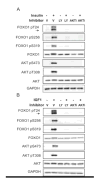FOXO1 is regulated by insulin and IGF1 in pituitary gonadotropes
- PMID: 25676570
- PMCID: PMC4363278
- DOI: 10.1016/j.mce.2015.02.006
FOXO1 is regulated by insulin and IGF1 in pituitary gonadotropes
Abstract
The FOXO1 transcription factor is important for multiple aspects of reproductive function. We previously reported that FOXO1 functions as a repressor of gonadotropin hormone synthesis, but how FOXO1 is regulated in pituitary gonadotropes is unknown. The growth factors, insulin and insulin-like growth factor I (IGF1), function as key regulators of cell proliferation, metabolism and apoptosis in multiple cell types through the PI3K/AKT signaling pathway. In this study, we found that insulin and IGF1 signaling in gonadotropes induced FOXO1 phosphorylation through the PI3K/AKT pathway in immortalized and primary cells, resulting in FOXO1 relocation from the nucleus to the cytoplasm. Furthermore, insulin administration in vivo induced phosphorylation of FOXO1 and AKT in the pituitary. Thus, insulin and IGF1 act as negative regulators of FOXO1 activity and may serve to fine-tune gonadotropin expression.
Keywords: Forkhead box O1; GnRH; Gonadotrope; IGF1; Insulin.
Copyright © 2015 Elsevier Ireland Ltd. All rights reserved.
Figures








Similar articles
-
Forkhead box O1 is a repressor of basal and GnRH-induced Fshb transcription in gonadotropes.Mol Endocrinol. 2013 Nov;27(11):1825-39. doi: 10.1210/me.2013-1185. Epub 2013 Sep 24. Mol Endocrinol. 2013. PMID: 24065703 Free PMC article.
-
Foxo1 mediates insulin-like growth factor 1 (IGF1)/insulin regulation of osteocalcin expression by antagonizing Runx2 in osteoblasts.J Biol Chem. 2011 May 27;286(21):19149-58. doi: 10.1074/jbc.M110.197905. Epub 2011 Apr 6. J Biol Chem. 2011. PMID: 21471200 Free PMC article.
-
FOXO1 transcription factor inhibits luteinizing hormone β gene expression in pituitary gonadotrope cells.J Biol Chem. 2012 Sep 28;287(40):33424-35. doi: 10.1074/jbc.M112.362103. Epub 2012 Aug 3. J Biol Chem. 2012. PMID: 22865884 Free PMC article.
-
The regulation of FOXO1 and its role in disease progression.Life Sci. 2018 Jan 15;193:124-131. doi: 10.1016/j.lfs.2017.11.030. Epub 2017 Nov 20. Life Sci. 2018. PMID: 29158051 Review.
-
The role of FOXO in the regulation of metabolism.Curr Diab Rep. 2009 Jun;9(3):208-14. doi: 10.1007/s11892-009-0034-5. Curr Diab Rep. 2009. PMID: 19490822 Review.
Cited by
-
Mechanistic insights into the role of FOXO in diabetic retinopathy.Am J Transl Res. 2022 Jun 15;14(6):3584-3602. eCollection 2022. Am J Transl Res. 2022. PMID: 35836845 Free PMC article. Review.
-
Critical Role of FoxO1 in Granulosa Cell Apoptosis Caused by Oxidative Stress and Protective Effects of Grape Seed Procyanidin B2.Oxid Med Cell Longev. 2016;2016:6147345. doi: 10.1155/2016/6147345. Epub 2016 Jan 19. Oxid Med Cell Longev. 2016. PMID: 27057282 Free PMC article.
-
IGF-1 defends against chronic-stress induced depression in rat models of chronic unpredictable mild stress through the PI3K/Akt/FoxO3a pathway.Kaohsiung J Med Sci. 2018 Jul;34(7):370-376. doi: 10.1016/j.kjms.2018.02.004. Epub 2018 Mar 6. Kaohsiung J Med Sci. 2018. PMID: 30063009 Free PMC article.
-
Linking diet to acne metabolomics, inflammation, and comedogenesis: an update.Clin Cosmet Investig Dermatol. 2015 Jul 15;8:371-88. doi: 10.2147/CCID.S69135. eCollection 2015. Clin Cosmet Investig Dermatol. 2015. PMID: 26203267 Free PMC article. Review.
References
-
- Galili N, Davis RJ, Fredericks WJ, Mukhopadhyay S, Rauscher FJ, 3rd, Emanuel BS, Rovera G, Barr FG. Fusion of a fork head domain gene to PAX3 in the solid tumour alveolar rhabdomyosarcoma. Nat Genet. 1993;5:230–235. - PubMed
Publication types
MeSH terms
Substances
Grants and funding
LinkOut - more resources
Full Text Sources
Other Literature Sources
Medical
Molecular Biology Databases
Research Materials
Miscellaneous

